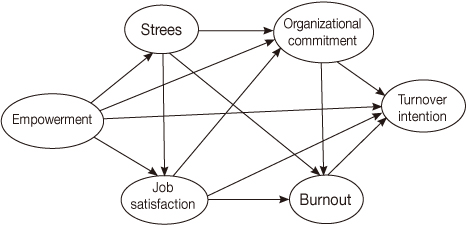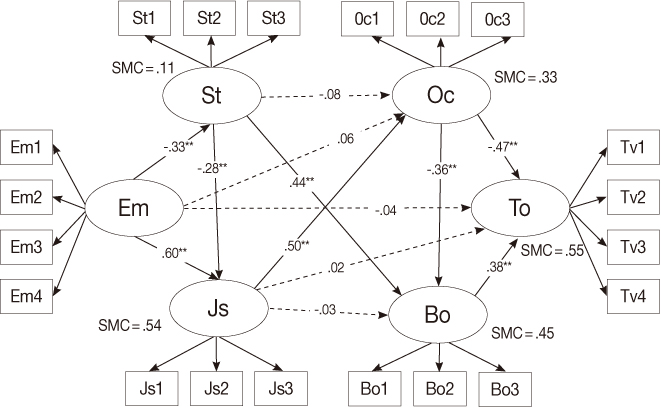A Predictive Model on Turnover Intention of Nurses in Korea
- Affiliations
-
- 1College of Nursing Science, Kyung Hee University, Seoul, Korea.
- 2College of Nursing Science, East-West Nursing Research Institute, Kyung Hee University, Seoul, Korea. sshan12@khu.ac.kr
- KMID: 1031102
- DOI: http://doi.org/10.4040/jkan.2011.41.5.633
Abstract
- PURPOSE
The purpose of this study was to propose and test a predictive model that could explain and predict Korean nurses' turnover intentions.
METHODS
A survey using a structured questionnaire was conducted with 445 nurses in Korea. Six instruments were used in this model. The data were analyzed using SPSS 15.0 and Amos 7.0 program.
RESULTS
Based on the constructed model, organizational commitment, and burnout were found to have a significant direct effect on turnover intention of nurses. In addition, factors such as empowerment, job satisfaction, and organizational commitment were found to indirectly affect turnover intention of nurse. The final modified model yielded chi2=402.30, p<.001), chi2/df=2.94, RMSEA=0.07, RMR=0.03, GFI=0.90, AGF=0.87, NFI=0.88, CFI=0.92 and good fit indices.
CONCLUSION
This structural equational model is a comprehensive theoretical model that explains the related factors and their relationship with turnover intention in Korean nurses. Findings from this study can be used to design appropriate strategies to further decrease the nurses' turnover intention in Korea.
Keyword
MeSH Terms
Figure
Cited by 4 articles
-
Phenomenological Study on Burnout Experience of Clinical Nurses Who have Turnover Intention
Jeung-Im Kim, Haeng-Mi Son, In Hee Park, Hee Jin Shin, Ji hyun Park, Mi Ock Cho, Seongui Kim, Mi Ock Yu
Korean J Women Health Nurs. 2015;21(4):297-307. doi: 10.4069/kjwhn.2015.21.4.297.Influence of Resilience and Job Embeddedness on Turnover Intention in General Hospital Nurses
Kyoung Ja Ko, Soo-Kyoung Lee
J Korean Acad Nurs Adm. 2019;25(4):362-372. doi: 10.11111/jkana.2019.25.4.362.Analysis of the factors of turnover intention of dental hygienists in dental hospitals
Jung Hwa Lee, Na Na Yoon
J Korean Acad Oral Health. 2021;45(2):92-99. doi: 10.11149/jkaoh.2021.45.2.92.Effects of Group Rational Emotive Behavior Therapy on the Nurses’ Job Stress, Burnout, Job Satisfaction, Organizational Commitment and Turnover Intention
Hye-Lyun Kim, Sook-Hee Yoon
J Korean Acad Nurs. 2018;48(4):432-442. doi: 10.4040/jkan.2018.48.4.432.
Reference
-
1. Bagozzi RP, Yi YJ. On the evaluation of structural equation models. Journal of Academy of Marketing Science. 1988. 16:74–94. doi: 10.1007/BF02723327.2. Barsky AT, Thoresen CJ, Warren CR, Kaplan SA. Modeling negative affectively and job stress: A contingency-based approach. Journal of Organizational Behavior. 2004. 25:915–936. doi: 10.1002/job.285.3. Bendapudi N, Leone RP. Managing business-to-business customer relationship following key contact employee turnover in a Vendor Firm. Journal of Marketing. 2002. 66(4):83–101. doi: 10.1509/jmkg.66.2.83.18476.4. Bluedorn AC. The theories of turnover: Causes, effects, and meaning. Research in the Sociology of Organizations. 1982. JAI Press;75–182.5. Chang HT, Chi NW, Miao MC. Testing the relationship between three-component organizational/occupational turnover intention using a non-recursive model. Journal of Vocational Behavior. 2007. 70:352–368. doi: 10.1016/j.jvb.2006.10.001.6. Cheon SD. A study about influence on job stress factors with leader-member exchange, job satisfaction, organizational commitment and turnover inclination. Korean Academy of Marketing Science Fall Conference. 2005. 673–696.7. Do YC. A study on the effects of empowerment on job stress variables. 2006. Seoul: KyungHee University;Unpublished master's dissertation.8. Gipson-Jones T. Perceived work and family conflict among African American nurses in college. Journal of Transcultural Nursing. 2009. 20:304–312. doi: 10.1177/1043659609334849.9. Gray B. The emotional labour of nursing: Defining and managing emotions in nursing work. Nurse Education Today. 2009. 29:168–175. doi: 10.1016/j.nedt.2008.08.003.10. Han SS, Park SW. Prediction factors on the organizational commitment in registered nurses. Journal of East-West Nursing Research. 2006. 12(1):5–13.11. Huang IC, Chuang CH, Lin HC. The role of burnout in the relationship between perception of organizational politics and turnover intentions. Public Personnel Management. 2003. 32:519–531. doi: 10.1037/0021-9010.92.2.438.12. Iverson RD. Employee intent to stay: An empirical test of a revision of the price and Mueller model. 1992. Iowa City, IA: The University of Iowa;Unpublished doctoral dissertation.13. Jaramillo F, Mulki JP, Locander WB. The role of time wasted in sales force attitudes and intention to quit. International Journal of Bank Marketing. 2006. 24(1):24–36. doi: 10.1108/02652320610642326.14. Jeong JH, Kim JS, Kim KH. The risk factors influencing turnover intention of nurses. Journal of Korean Academy of Nursing Administration. 2008. 14:35–44.15. June KJ, Byun SW. Nurse's burnout research throughout the past 10 years in Korea. Journal of Korean Academy of Nursing Administration. 2009. 15:305–313.16. Kim CH, Yang SS, Kim YJ, Son YJ, You MA, Song JE. A structural equation model of nurses' turnover intention. Journal of Korean Academy of Nursing Administration. 2009. 15:550–562.17. Kim HK, Ji HS, Ryu EK, Lee HJ, Yun SE, Jeon MK, et al. Factors influencing on burnout of the nurses in hospitals. Clinical Nursing Research. 2005. 10(2):7–18.18. Kim HS. A study on the relationship of job stress, job satisfaction, organizational commitment and turnover intention of hotel employees. Korean Journal of Tourism Research. 2005. 19:203–225.19. Kim IW. A structure model on head nurse's leadership. 2005. Seoul: KyungHee University;Unpublished doctoral dissertation.20. Kim JS. The relations among role stress, strain and burnout of the workers in a hotel. 2006. Seoul: Kyonggi University;Unpublished doctoral dissertation.21. Kim KS. AMOS 4.0 Analysis structural equation modeling. 2004. Seoul: SPSS Academy.22. Lee SH. The effects of empowerment on job satisfaction and organizational commitment. Korea Journal of Tourism and Hospitality Research. 2005. 19(3):95–108.23. Mobley WH. Employee turnover: Causes, consequences, and control. 1982. Reading, Mass: Addison-Wesley Publishing Co.;10–11.24. Mowday RT, Steers RM, Porter LW. The measurement of organization commitment. Journal of Vocational Behavior. 1979. 14:224–247.25. Park BN, Park JS. The influence of empowerment on job satisfaction, task performance and turnover intention by hospital nurses. Journal of Korean Academy of Nursing Administration. 2008. 14:150–158.26. Park HH. Influence on job satisfaction and organizational commitment of clinical nurse's power and empowerment. 2005. Seoul: Chung Ang University;Unpublished master's dissertation.27. Pines AM, Keinan G. Stress and burnout: The significant difference. Personality and Individual Differences. 2005. 39:625–635. doi: 10.1016/j.paid.2005.02.009.28. Price JL. The study of turnover. 1977. Ames, IA: Iowa State University Press.29. Spreitzer GM. Psychological empowerment in the workplace. Academy of Management Journal. 1995. 38:1442–1465.
- Full Text Links
- Actions
-
Cited
- CITED
-
- Close
- Share
- Similar articles
-
- A Prediction Model on the Male Nurses' Turnover Intention
- Predictive Factors of Turnover Intention among Intensive Care Unit Nurses
- A Structural Model of Hospital Nurses' Turnover Intention: Focusing on Organizational Characteristics, Job Satisfaction, and Job Embeddedness
- The Influence of Grit and Nursing Work Environment on Turnover Intention among General Hospital Nurses
- Effects of Self-efficacy, Career Plateau, Job Embeddedness, and Organizational Commitment on the Turnover Intention of Nurses



